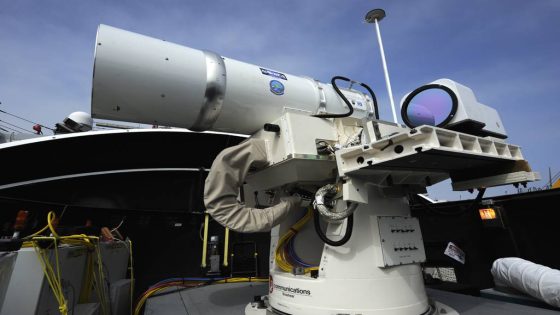Development and deployment of directed-energy weapons would enhance defense across the Greater Middle East, where Iran-backed militants are targeting U.S. troops with missiles and explosive drones, according to the leader of U.S. Central Command.
Army Gen. Michael Kurilla told lawmakers on March 7 that he would “love” to have the Navy deploy more directed-energy arms capable of downing drones. Having supplemental directed energy on hand, he added, would also mean expending fewer U.S. missiles, which can cost millions of dollars a pop. Iranian drones being funneled to extremist groups can cost thousands of dollars each.
“The bigger concern is if you start talking about swarms. We need to continue to invest in things like high-power microwave to be able to counter a drone swarm that is coming at you,” Kurilla said during the Senate Armed Services Committee hearing in Washington. “Nothing is 100%. At some point the law of statistics will come up. You have to have a layered defense.”
High-energy lasers and microwave weapons are capable of zapping overhead threats in ways dissimilar to traditional munitions and at a fraction of the cost. Lasers can fire at the speed of light and punch holes through material, while microwaves can fry electronics at a distance, rendering tech obsolete. Both are considered a critical element of layered defense, or having multiple countermeasures ready to thwart different threats in different situations.
The Defense Department has for decades pitched money into directed-energy weapons, an average $1 billion annually in the past three years, according to the Government Accountability Office, a federal watchdog.
RELATED
At least 31 directed-energy initiatives are underway across the department, with some more mature than others. Among them are Lockheed Martin’s High Energy Laser with Integrated Optical-dazzler and Surveillance, or HELIOS, installed aboard the Navy destroyer Preble in 2022, and Epirus’ Leonidas, delivered to the Army in 2023 in furtherance of its Indirect Fire Protection Capability.
Bringing such systems to fruition — let alone mass production — has proven tricky. Aside from their technological complexity, laser- and microwave-based weaponry demand precious components and materials such as germanium and gallium.
Kurilla on Wednesday said the Army “sent us some directed-energy mobile short-range air defense” that are being experimented with. He provided no details about initial results. The service dispatched four Stryker-mounted 50-kilowatt laser prototypes in February, Breaking Defense reported.
Militants across the Greater Middle East have in recent months conducted more than 175 attacks on U.S. and allied forces. A drone strike in Jordan, at the Tower 22 installation near al-Tanf garrison, killed three troops in January. A Houthi missile attack on a commercial ship in the Gulf of Aden this month killed three crew members, as well, and forced an evacuation of the vessel.
“This is not the same central region as last year,” Kurilla said. “Iran’s expansive network of proxies is equipped with advanced, sophisticated weaponry, and threatens some of the most vital terrain in the world with global and U.S. implications.”
Colin Demarest is a reporter at C4ISRNET, where he covers military networks, cyber and IT. Colin previously covered the Department of Energy and its National Nuclear Security Administration — namely Cold War cleanup and nuclear weapons development — for a daily newspaper in South Carolina. Colin is also an award-winning photographer.
Source Agencies



